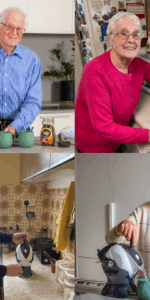As the population continues to age, the concept of ”ageing in place” has gained prominence. Many seniors wish to remain in their homes as they grow older, maintaining their independence and familiar surroundings. Occupational therapists (OTs) play a crucial role in making this desire a reality. Today, we will explore the significance of adapting homes for ageing in place and provide valuable insights from an occupational therapy perspective.
Understanding the Importance of Ageing in Place:
Ageing in place refers to the idea of seniors living in their homes comfortably and safely as they age, rather than moving to a care facility. This concept is not only emotionally fulfilling for seniors but also cost-effective when compared to institution-based care. Occupational Therapists (OTs) are uniquely qualified to help seniors achieve this goal by assessing the home environment and making necessary modifications.
The Role of Occupational Therapists:
Home Assessments:
- OTs begin by conducting comprehensive home assessments. They evaluate the physical layout, lighting, safety features, and potential hazards in the home.
They consider the individual’s mobility, vision, and cognitive abilities to tailor modifications accordingly.
Personalised Modifications:
- OTs recommend and implement personalised modifications, such as installing grab bars in bathrooms, ramps for wheelchair access, and non-slip flooring to prevent falls.
They may suggest simple changes like rearranging furniture to improve accessibility.
Assistive Devices:
- OTs assist in selecting and integrating assistive devices like mobility aids (like our Uccello Kettle), adaptive utensils, and communication devices to enhance daily living.
Safety Measures:
- Implementing safety measures, such as adding motion-activated lighting and fire alarms with visual and auditory cues, is a priority for OTs.
Education and Training:
Occupational therapists provide education and training to both seniors and their caregivers on using these modifications and devices effectively.
Benefits of Adapting Homes for Ageing in Place:
Independence and Dignity:
Seniors maintain their independence and autonomy, which is crucial for their emotional well-being and self-esteem.
Cost-Efficiency:
- Ageing in place is often more affordable than moving to a nursing home or assisted living facility.
Emotional Well-being:
- Staying in a familiar environment surrounded by memories can have a positive impact on a senior’s mental health.
Reduced Hospitalisation:
- Well-designed homes can reduce the risk of accidents and falls, leading to fewer hospitalisations.
Occupational therapists are instrumental in making the dream of ageing in place a reality for many seniors. By carefully assessing and adapting home environments, OTs ensure that older adults can live safely and independently in the comfort of their own homes. As the ageing population continues to grow, the role of occupational therapists in facilitating this transition becomes increasingly vital, improving the quality of life for countless individuals.













Leave a Comment